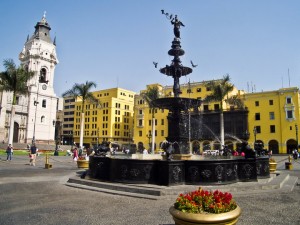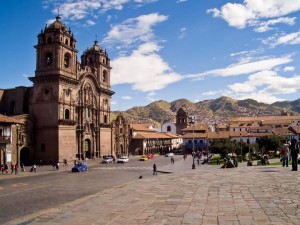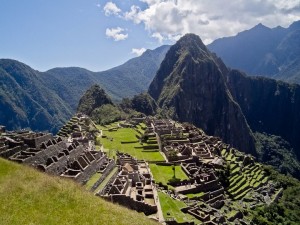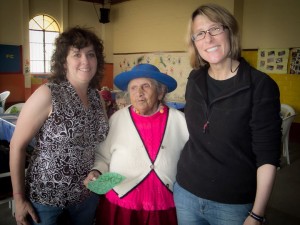I own it. I’m a shallow traveler. When choosing a destination my top criteria are visual drama and cultural civility. In other words, a beautiful place with a relative absence of war, crime, despots, or other forms of antisocial behavior. Delicious cuisine and interesting culture or wildlife are also high on the list. So when I had the opportunity to travel toPeru, it seemed like a great fit on all those dimensions. Plus there was another exciting aspect – I was also going as a Cross Cultural Solutions (CCS) volunteer. But more on that later.
Cusco is a breathtaking little city, both metaphorically and literally. Situated at an altitude of over 11,000 feet, the air is thin. One is advised to hydrate and rest upon arrival in order to acclimate to the altitude – advice I promptly ignored in favor of taking photos of the quaint cobblestone streets and surrounding mountains. For this I was punished with a blazing headache. This did not stop me from touring the nearby Incan complex Sacsayhuaman, a UNESCO World Heritage designated site with a spectacular view of the valley below. But as the evening of the first day wore on a merchant took pity on me and gave me an aromatic herb called muna (pronounced “mun-ya). Her advice was to inhale the aroma of the foliage to alleviate symptoms. Along with a good night’s sleep, it did the trick. The next day I was as good as new.
My friends and I ate several times at the same restaurant in Cusco. We’d randomly picked it out for lunch while walking around the lovely Plaza de Armas our first day out. It was so good that we went back. The name is Papillion and it has a great view of the Plaza from the balcony. What a find! The quinoa soup was mouthwatering and I spent the rest of the trip stalking the recipe. Quinoa is a nutritious staple of the Peruvian diet and was considered sacred by pre-Columbian civilizations. At one point one of my travelling friends also shared a bite of her alpaca. Tender, mild and nicely prepared. Our last night there a local band played traditional music as we sipped Pisco sours. It may have been the effect of the notoriously lethal Pisco, the altitude, or the good company, but it felt pretty magical.
The legendary Machu Picchu embodies the cliché “pictures do not do it justice.” The scenery along the way to Aguas Calientes is just a prelude. It is a lengthy trip (early morning bus ride to the train station) but the time flies with so much see. Since at all times we were treading the well-worn “Gringo Trail.”, there was of course evidence of this – merchants selling their wares. But it was not obtrusive.
I found the people of Peruto be approachable and warm. How many major cities could you ask a police officer in a foreign language to help you flag a cab, and have him drop everything to help? This happened our last day in downtown Lima.
This leads me to less shallow criteria for choosing a travel destination – historical and cultural significance. I’m embarrassed to say these criteria are not always high on my list when choosing a destination. Witnessing the location where someone did something important or where something significant happened are not in and of themselves what are compelling to me – it’s the ‘whys’ and the implications that are the interesting bits. And since travel is logistics-heavy by its very nature, more often than not there isn’t the opportunity for deeper reflection. Which leads to an experience many travelers have shared – the dull, 10 minute guidebook spiel, and then it’s off the next thing.
So I was caught off guard by the sheer poignancy of the historical elements that I experienced in Peru.
First, there is the small matter of Machu Picchuitself. The fact that it represents a human feat of such awesome magnitude rendered in such beautiful form that one cannot help but be humbled in its presence and ponder the exceptional characteristics of the civilization that created it, cannot be overstated.
Next was Villa El Salvador. This is where I volunteered with CCS while inLima. Travelling as part of CCS was not new to me. The previous year I’d travelled to Morocco with Sucheta, spending time at a local orphanage in Rabat. It did not prepare me for what I was about to experience in Peru. Villa ElSalvadoris a marvel of the human spirit’s drive for self-organization and democracy. The origins of this community as a suburb of Lima are as compelling asAmerica’s fight for independence, and it has gained notoriety internationally for its unique origins and successes. The abuelos, or elders, that I worked with there are as sweet as they are heart breakingly vulnerable. I was deeply moved by their circumstances.
And finally, an exhibit at the Lima Museum of the Nation has left its mark on my soul. On the upper floor, isolated from the rest of the museum, is a chilling black and white photography exhibit on the history of The Shining Path. I wonder how many Americans know about this dark and recent period in Peru’s history – a political insurgency that turned citizen against citizen, government against citizen, and led to the tragic death or disappearance of nearly 70,000 people between 1980 and 2000.
As a destination Peru has it all. You don’t have to be a “shallow traveler” like me to appreciate its beauty and culture. And having visited, I’ve come away a bit deeper for the experience.
~ By guest blogger, Cheryl Garin, who traveled with me to Morocco and has become a dear friend and supporter.




